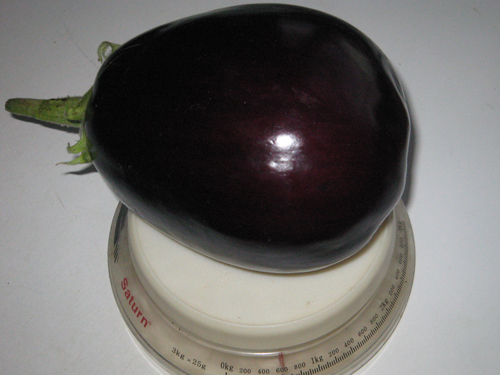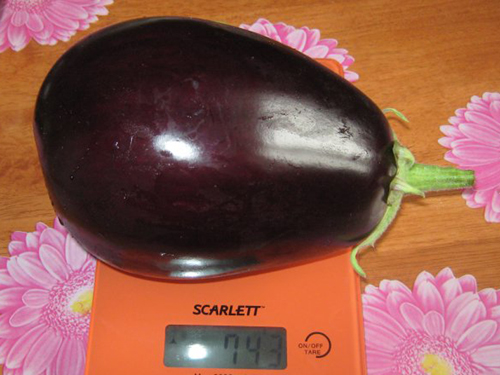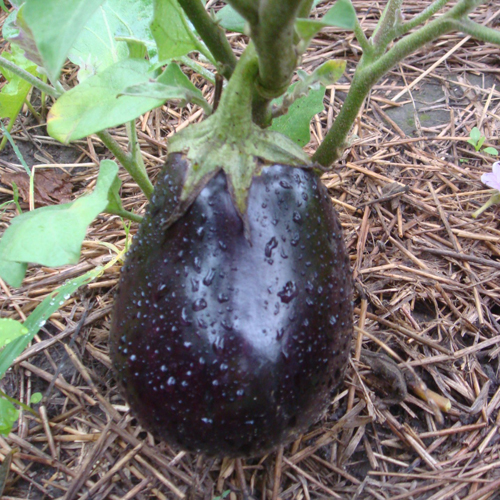Eggplant variety Clorinda (F1)
There are many varieties of eggplants. Some captivate with their beautiful appearance, the second - with their taste, and still others - with their yield. Not so long ago, in 2005, the Dutch company Monsanto, engaged in the development of new varieties using biotechnology, presented a new product to the judges of connoisseurs - Clorinda eggplant. He combined all the listed qualities and pleased with some others. It was entered into the State Register of Plants of the Russian Federation in 2007, with admission to cultivation in all regions of Russia. Recommended for open and closed ground. It is a hybrid, therefore it is always designated with the F1 marking.

Description
The plant is upright, medium to tall. Some specimens reach a height of one meter. The plant looks powerful. The stalk is thick, with short internodes. The color is purple, but poorly expressed due to the low content of anthocyanins. Pubescence is medium to strong. Leaves are not very large, oval, with a slightly elongated tip, alternately arranged, green. The edges are slightly wavy. The surface of the plate is rough, with clearly visible venation. Clorinda's flowers are of normal size, light purple, solitary. The peduncle is not long, thickening closer to the ovary. The spines on the calyx are practically absent.
The fruits of the variety are oval, fleshy. On average, they pull out 300 - 320 grams, but often they grow just huge - kilogram, and even heavier. The skin is thin, but strong, elastic, highly glossy, evenly colored, dark purple, in the period of full ripeness it can acquire a brilliant-black color. Eggplant length 25 cm, diameter 12 cm. The flesh is whitish, dense, does not contain bitterness. The cut does not oxidize for a long time. A distinctive feature of the variety is the absence or insignificant amount of seeds. Mushroom taste and aroma, pronounced.

Characteristics
- Depending on the region of cultivation, the crop ripens early or mid-early. On average, the growing season is 68 days;
- The marketable yield of the variety in the open field reaches 2.8 kg per 1 sq. meters. In the greenhouse, this indicator increases, since the fruiting period in protected ground is extended;
- the plasticity of the hybrid helps it to quickly cope with stressful conditions. The ovary appears even in cool weather;
- the immunity of Clorinda is good, the applicants especially highlight the resistance to the tobacco mosaic virus;
- excellent transportability due to dense pulp and strong skin;
- keeping quality can also be called good;
- the way of use is universal. Eggplants are stewed, baked in the oven and grilled, fried, pickled, stuffed. The fruits are great for canning.

Agrotechnics
The seed method of planting the variety is possible only in warm regions. I sow seed in the soil in mid-March. If the weather is unstable, you can cover the bed with a film. The sowing depth is about 2 cm. The seedling method is more popular, as it makes it possible to get the harvest a little earlier than the due date. For seedlings, seeds are sown in late February or early March. The seedlings of Clorinda are transferred to a permanent place when they are 2 months old, around the end of May or the beginning of June. Planting pattern: distance between plants 30 cm, row spacing - up to 50 cm.
The variety is demanding on lighting, so the place should be sunny. The best predecessors of eggplant are melons, greens and legumes. The plant is demanding for watering. Long periods of drought can cause flowers and ovaries to fall off. It responds to the introduction of timely top dressing with an increase in yield.
A feature of growing this variety is the need to tie up the plant. If the fruits are poured large, under a kilogram or more, it is advisable to substitute a support for them, for example, an inverted bucket from under mayonnaise.
The wonderful hybrid Clorinda will delight the gardener not only with easy care and good yield. It also has excellent taste and seedless flesh. Eggplant can be grown not only in the open field, but also under a film shelter or in a greenhouse, which makes it possible to extend the fruiting period even in cold regions. Of the shortcomings, perhaps, one can single out the need to control the frequency of watering and the annual purchase of seed.








